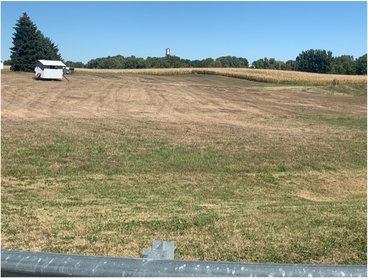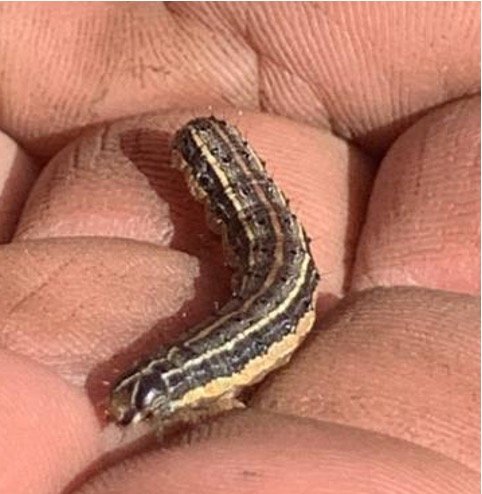9/23/2021 | Volume 24 number 14
This newsletter and the advice herein are free. You usually get what you pay for.
Greetings,
You might want to look at your cereal rye cover crops and grass pastures and grass hay ground. Last week, I received a report of armyworm damage to a Redwood County rye cover crop from consultants at Centrol. A photo contained a larva that looked like a fall armyworm (FAW). Although unusually high levels of FAW were reported from the mid-South in July and subsequently the eastern Corn Belt, Iowa, and Nebraska, I was hoping that this was an isolated infestation of these migratory insects.
No such luck. Today, I received an email from Andy Linder about armyworm infestations in some Faribault County cover crops, grass hay, and lawns (Figure 1). The appearance, and host preference, of the larvae are FAW not the related but more common (in Minnesota) true armyworm (TAW).
- FAW differ from TAW by the presence of a rectangle of four dark spots on the end of the abdomen and a prominent, light, inverted Y suture on the front head. The suture may be less pronounced on small larvae (Figures 2 & 3)
- FAW are tropical and subtropical insects that cannot tolerate freezing. Overwintering populations occur from Central and South America and as far north as southern Florida and southern Texas. Problems from FAW are rare in Minnesota and migrant moths and resulting larvae typically occur late in the growing season.
- Like the true armyworm, FAW larvae feed as a group, moving en masse when they deplete their food. A generation takes a month or so to complete depending on temperature.
- There are two strains of FAW. Although they look-alike, they have different host plant preferences. The corn strain prefers corn, sorghum, cotton, and soybeans. The rice or grass strain prefers rice, alfalfa, and pasture grasses. Based on observations in states to the south, the strain causing the concerns this year are the rice strain or possibly a mix of the two strains.
- Although FAW can feed on corn and move from grasses to soybeans, both crops are now far enough along to be a less attractive host. However, small grasses such as cereals, pasture, and turf grasses are still attractive and are at higher risk.
- Depending on developmental stage, larvae can be active until frost. Full grown larvae are 1¼ to 1½ inch long. A treatment might be avoided when larvae are large, a frost is expected or low value of the grass forage.
- The growing point of cereal rye should still be below ground at this time and below the feeding injury.
- Established grassed should survive but may be weakened. Small, fall-seeded grasses might be killed if feeding is near the base.
- A sweep net can be a helpful tool to find FAW in grasses. A generic threshold for FAW in hay and pastures is 2-3 larvae / square foot.
- Mowing and baling can be used as a management tool but at this point, we are late enough in the season that we are on the bubble for time to adequately resupply root reserves of highly managed hay.
- Earlier reports from the mid-South indicated unusually poor control with pyrethroid insecticides. Insects in Minnesota are offspring of these populations. Chlorpyrifos is not labeled on grass hay or pastures. There are several other labeled insecticide options for grass hay and pastures that may provide improved control for pyrethoid resistant/tolerant FAW. The growth regulators [e.g, Dimilin (group 15) and Intrepid(group 18)) can provide control. They take some time to kill and Dimilin is less effective on large larvae. Chlorantraniprole [e.g., Prevathon, Besiege (group 28)] also provide improved control for pyrethroid resistant/tolerant and has a 0-day interval for grazing and haying.
- As always, refer to the label for labeled crops, rates, grazing and pre-harvest intervals.
I don’t have a good feel for how widespread Minnesota FAW infestations are. The moths could have come in anywhere we had sustained southerly winds. We picked up a few in the SWROC black light trap in August but not an unusually large number.
Two additional articles that you may find useful are:
- Fall Armyworm Management Considerations in Alfalfa and Cover Crops
- Fall Armyworm Outbreak: Round Two
Minnesota is not the tropical environment where this insect originates. You might check some of the FAW larvae for sweaters with SEC football logos. Hopefully, most of the migrating moths had an aversion to Gophers and lefse.
Happy trails,
Bruce



